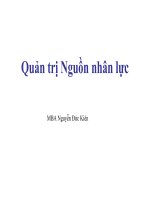Bài giảng QUản trị nguồn nhân lực part 2 eng
Bạn đang xem bản rút gọn của tài liệu. Xem và tải ngay bản đầy đủ của tài liệu tại đây (764.25 KB, 29 trang )
Human Resource Management
Session 2
JOB ANALYSIS, STRATEGIC
PLANNING, AND HUMAN
RESOURCE PLANNING
1
Questions Job Analysis Should Answer
• What physical and mental tasks does the
worker accomplish?
• When is the job to be completed?
• Where is the job to be accomplished?
• How does the worker do the job?
• Why is the job done?
• What qualifications are needed to perform the
job?
2
Job Analysis: A Basic Human Resource Management Tool
Tasks
Responsibilities
Duties
Human Resource Planning
Recruitment
Selection
Training and Development
Job Descriptions
Performance Appraisal
Job
Analysis
Compensation and Benefits
Job Specifications
Safety and Health
Employee and Labour
Relations
Legal Considerations
Knowledge
Skills
Abilities
Job Analysis for Teams
3
Job Analysis Methods
•
•
•
•
•
Questionnaires
Observation
Interviews
Employee recording
Combination of
methods
4
Questionnaires
• Typically quick and economical to use
• Structured questionnaire to employees
• Problem: Employees may lack verbal skills
• Some employees tend to exaggerate significance of
their tasks
5
Observation
• Job analyst watches worker perform job tasks and
records observations
• Used primarily to gather information on jobs
emphasizing manual skills
• Used alone is often insufficient
• Difficulty: When mental skills are dominant in a job
6
Interviews
• Interview both employee and
supervisor
• Interview employee first, helping
him or her describe duties
performed
• Then, analyst normally contacts
supervisor for additional
information
7
Employee Recording
• Describe daily work activities
in diary or log
• Problem: Employees
exaggerating job importance
• Valuable in understanding
highly specialized jobs
8
Conducting Job Analysis
•
People who participate in
job analysis should include,
at a minimum:
– Employee
– Employee’s immediate
supervisor
9
Job Description
• Document that states tasks,
duties, and responsibilities of job
• Vitally important that job
descriptions are both relevant
and accurate
10
Content of a Job Description
• Job Identification – Job title, department,
reporting relationship, and job number or code
• Job Analysis Date – Aids in identifying job
changes that would make description obsolete
• Job Summary – Concise overview of job
• Duties Performed – Major duties
11
Problems If Job Specifications
Are Inflated
• May systematically eliminate
minorities or women from
considerations
• Compensation costs will increase
• Job vacancies will be harder to fill
12
Timeliness of Job Analysis
Rapid pace of
technological change
makes need for
accurate job analysis
even more important
now and in the
future.
13
Strategic Planning
• Strategic planning - Process by
which top management
determines overall
organizational purposes and
objectives and how they are to
be achieved
• Strategic planning at all levels
can be divided into four steps
14
Strategy Implementation
• Leadership
• Organizational Structure
• Information and Control
Systems
• Technology
• Human Resources
15
Human Resource Planning
Systematic process of
matching internal and external
supply of people with job
openings anticipated in the
organization over a specified
period of time
16
Human Resource Planning Process
External Environment
Internal Environment
Strategic Planning
Human Resource Planning
Forecasting Human
Resource
Requirements
Comparing
Requirements and
Availability
Demand =
Supply
Surplus of Workers
Shortage of
Workers
No Action
Restricted Hiring, Reduced
Hours, Early Retirement,
Layoffs, Downsizing
Recruitment
Forecasting Human
Resource
Availability
Selection
17
Forecasting Human Resource
Requirements
• Zero-based forecasting - Uses
current level as starting point for
determining future staffing needs
• Bottom-up approach - Each level
of organization, starting with
lowest, forecasts its
requirements to provide
aggregate of employment needs.
18
Forecasting Human Resource
Requirements (Cont.)
• Relationship between Volume of Sales and
Number of Workers Required
• Simulation Models - Simulation is a
forecasting technique for experimenting with
real-world situation through mathematical
model representing that situation. A model is
an abstraction of the real world.
19
The Relationship of Sales Volume to
Number of Employees
Number of
Employees
500
400
300
200
100
0
10
20
30
40
Sales (thousands)
50
60
20
Shortage of Workers Forecasted
• Creative recruiting
• Compensation incentives –
Premium pay is one method
• Training programs – Prepare
previously unemployable people
for positions
• Different selection standards
21
Surplus of Employees
• Restricted hiring –
employees who leave are
not replaced
• Reduced hours
• Early retirement
• Downsizing - Layoffs
22
Downsizing
• Also known as restructuring and rightsizing, is
reverse of company growing and suggests onetime change in organization and number of
people employed
• Retention bonuses are used to entice
terminated employees to remain for short
periods of time to ensure continued services
23
Negative Aspects of Downsizing (Cont.)
• Institutional memory lost
• Remaining workers
required to do more
• When demand for
products/services returns,
firm may realize it has cut
too deep
24
Outplacement
• Laid-off employees given
assistance in finding employment
elsewhere
• Companies use outplacement to
take care of employees by
moving them successfully out of
company rather than having to do
it on their own
25









